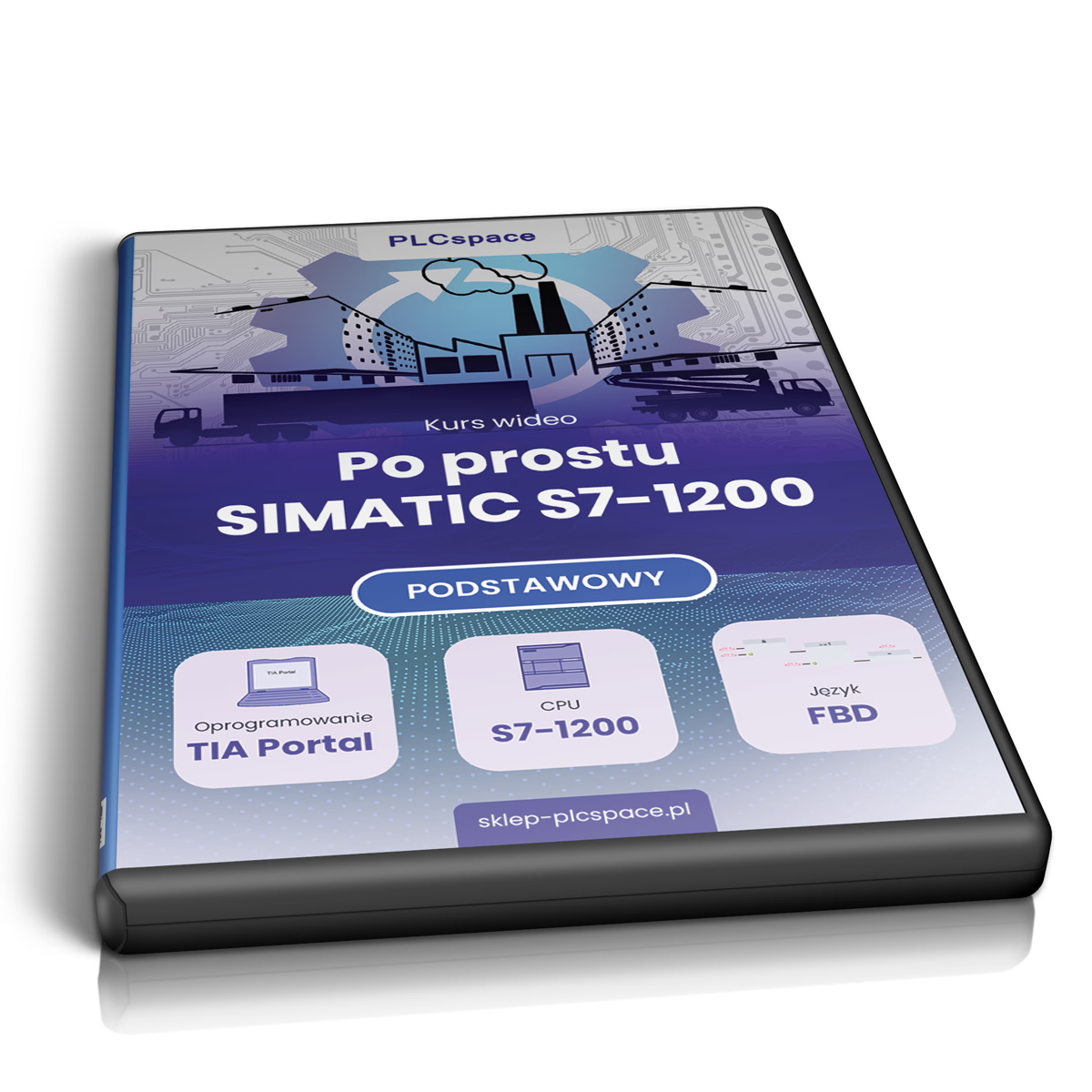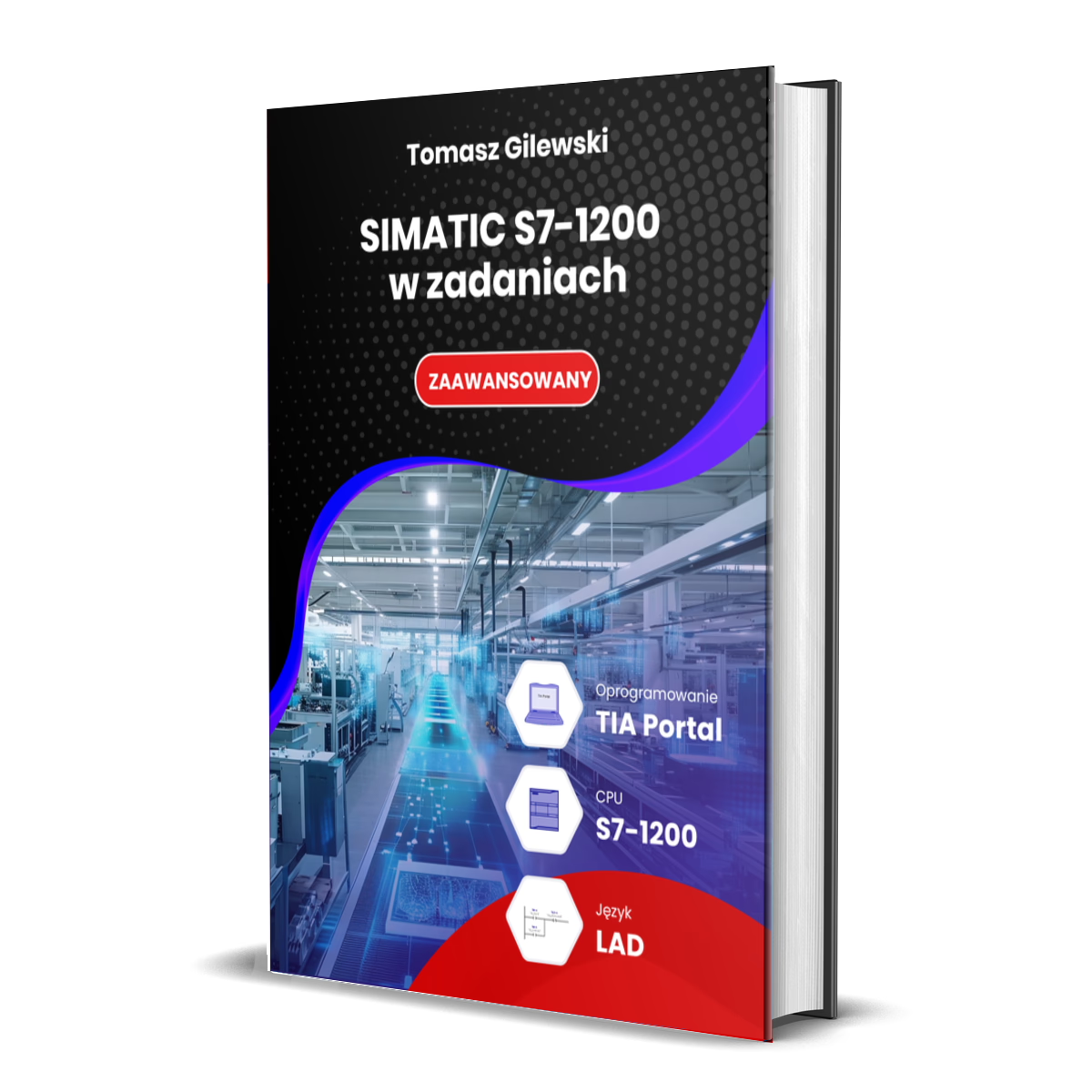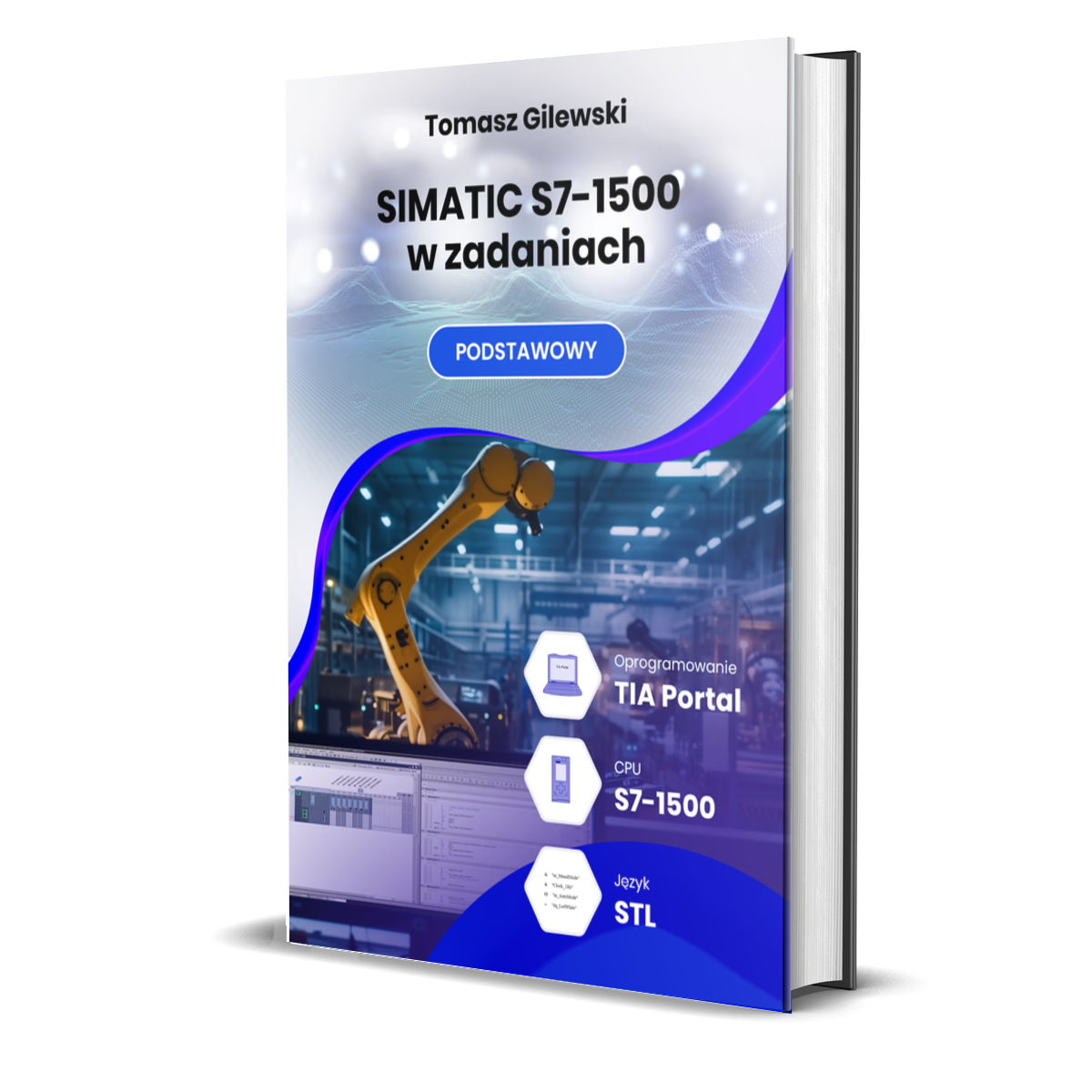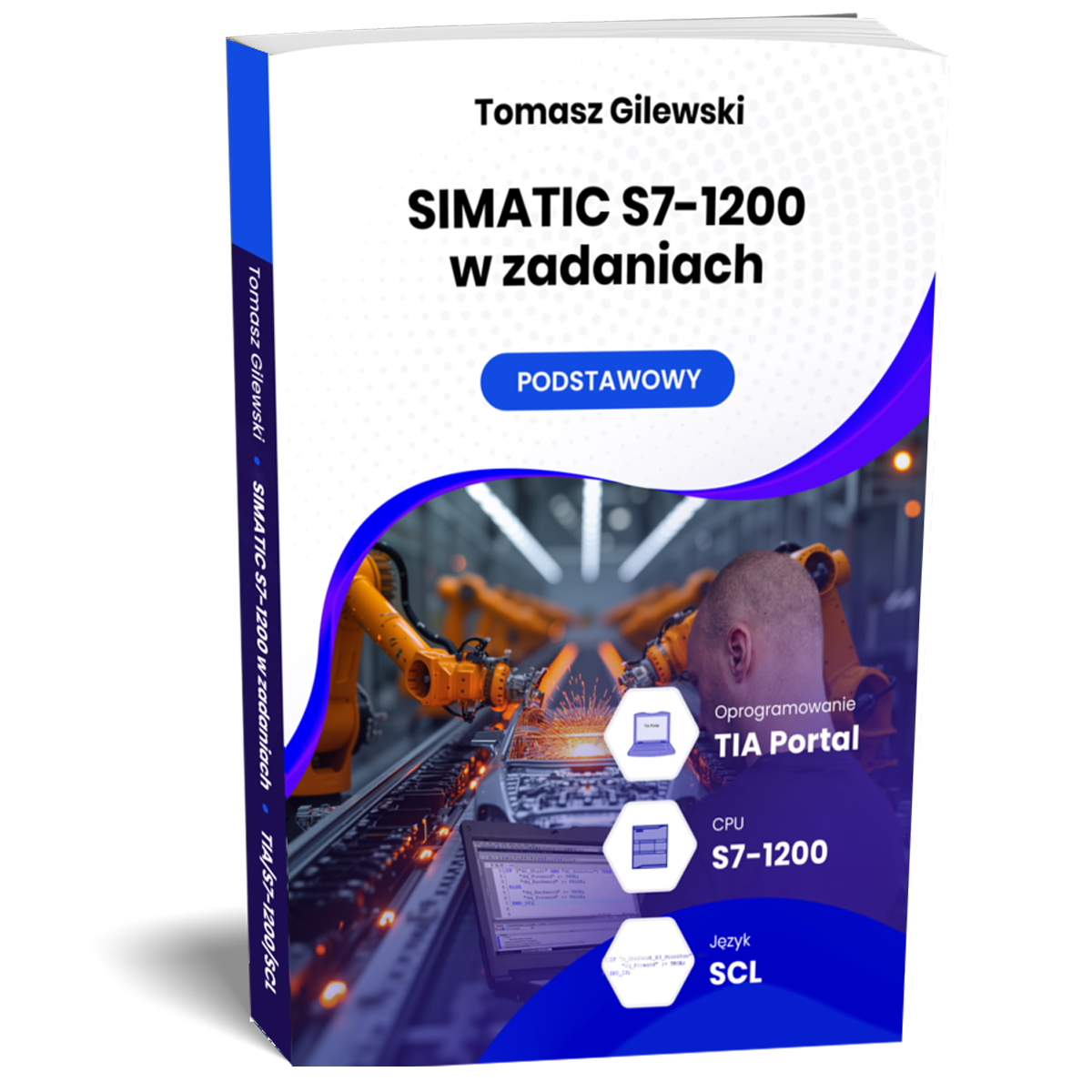Simply SIMATIC S7-1200
- Level:
The development environment used in the course
- Software:
Core unit family used in the course
- CPU:
A set of rules that are used to develop programme code
- Language:
Frequency converter (inverter) family used in the course
- Drive
479.00 zł – 499.00 zł
What do you get when you enrol on a PLC programming course?
Don't worry, we won't throw complicated knowledge at you that you would find difficult to assimilate. That's not our way at all! Our course is designed to gradually introduce you to the basics of PLC. As part of the training you will be given carefully selected tools to help you learn:
Simply SIMATIC S7-1200
Welcome to the course "Simply SIMATIC S7-1200". - Your ticket to the world of Simatic PLCs. Whatever your industry, machine automation is becoming a mainstay. This course focuses on an important family of PLCs - the Simatic S7-1200. You may have already heard about their flexibility in theoretical lessons, but now you will learn how to use them in practice.
Our PLC course will open the door to programming Siemens controllers, even if you have not had any previous experience with them. You will gain practical knowledge that you can easily apply in your daily work.
If you have a technical background and dream of a career in automation, but lack a starting point, you've come to the perfect place! Our Simatic PLC programming course will make sure that you surprise employers with your knowledge and unconventional approach to the subject.
What is the Siemens Simatic PLC programming course about?
In the course "Simply SIMATIC S7-1200" - Your key to the world of Simatic PLCs. Our PLC programming training proposal has been carefully composed to guide you through the complete scope of this subject - from the absolute basics to the intermediate level. You will master topics that are invaluable in many professions where exposure to industrial programming is essential.
Want to gain the skills to program and supervise machines in a factory? Understanding the programming of Siemens Simatic PLCs will open the door to a better understanding of the relationships between components.
Our course focuses on the popular Siemens S7-1200 controller, which works perfectly with TIA Portal software. It is a powerful development environment and operation of the Simatic S7-1200 controller is possible in three languages. Our training focuses on the FBD language, or functional block diagram, which is great for beginners.
With the tasks included in the course, you will move into a 'virtual factory' where practice becomes reality. Programming Siemens S7-1200 PLCs is convenient as it does not require the purchase of additional software or hardware. Everything plays out in the TIA Portal environment, available for free download from the manufacturer's website. This is the perfect place to understand that learning to program PLCs does not have to be difficult and theoretical.
Ready to learn the ins and outs of PLC programming in FBD language? Choose our course "Simply SIMATIC S7-1200" and start laying a solid foundation for your future automation career.
Knowledge test:
Is this course for you? Take this test MULTIPLE choice to check it out.
Egzamin Summary
0 of 9 Questions completed
Questions:
Information
You have already completed the egzamin before. Hence you can not start it again.
Egzamin is loading…
You must sign in or sign up to start the egzamin.
You must first complete the following:
Results
Results
0 of 9 Questions answered correctly
Your time:
Time has elapsed
You have reached 0 of 0 point(s), (0)
Earned Point(s): 0 of 0, (0)
0 Essay(s) Pending (Possible Point(s): 0)
Categories
- Not categorized 0%
- 1
- 2
- 3
- 4
- 5
- 6
- 7
- 8
- 9
- Current
- Review
- Answered
- Correct
- Incorrect
-
Question 1 of 9
1. Question
Do the interrupt blocks change the cycle time?
CorrectIncorrect -
Question 2 of 9
2. Question
In which languages can code be written for the S7-1200 PLC?
CorrectIncorrect -
Question 3 of 9
3. Question
What states (values) can the bit assume?
CorrectIncorrect -
Question 4 of 9
4. Question
Is "state 0" returned by
CorrectIncorrect -
Question 5 of 9
5. Question
How many bits does a BYTE type consist of?
CorrectIncorrect -
Question 6 of 9
6. Question
What is the result of a comparison operation?
CorrectIncorrect -
Question 7 of 9
7. Question
What type of memory is defined as ephemeral (loss of data after power failure) ?
CorrectIncorrect -
Question 8 of 9
8. Question
Which data types consist of 32 bits?
CorrectIncorrect -
Question 9 of 9
9. Question
What bytes are included in the address %ID0 ?
CorrectIncorrect
Key information about the course
Discover how you will eagerly reach for additional knowledge yourself. Our course is not just about the theoretical basics of programming, it is also about practical skills, concrete knowledge and proven techniques used by PLC professionals. We believe that our training is not just about learning, it is also about acquiring concrete tools and tricks that are everyday practice in the industry.
We are not limited to dry definitions - we will show you how programming works in a real industrial environment. You will gain concrete skills and insights into practical applications. We will teach you not only the basics, but also advanced techniques and tricks that professionals use.
Our instructors will introduce you to the world of analytical thinking, crucial for any PLC programmer. You will arm yourself with the tools to approach complex problems with confidence and efficiency. After the course, you will surprise employers with your professionalism and the skills you will have acquired during our training programme.
Although the work of an automation programmer may seem like a solo effort, the reality is often quite the opposite. In a professional environment, PLC programmers form a close-knit team, working together on projects. After completing our course, you will feel confident as part of this team, able to communicate and collaborate effectively.
You don't need to be afraid of communicating in a professional environment. Our course not only provides you with programming skills, but also shows you how to present your results in front of managers, investors and teammates. You will learn how to choose optimal solutions that take into account both the time and cost required to implement them. As a result, you will become a confident and effective team member, able to achieve common goals in PLC programming.
On our SIMATIC S7-1200 PLC programming course in FBD language, you will not only gain a solid foundation, but you will also learn how to deal with the pitfalls and problems that you may often encounter. Unlike many courses available online that focus on imparting theory, we go one step further.
We offer you concrete solutions to the pitfalls and difficulties that beginners often face. We do not leave you helpless, but explain how to avoid these problems and why it is so important. Our course will not only enhance your programming skills, but also show you how to effectively deal with challenges that may arise in practice.
In the course, we will present you with a virtual factory that reflects the typical challenges faced by automation professionals working in industry. You will gain practical experience and master the stress of working in a real environment. Using Factory I/O applications, you will be able to test a variety of solutions without the risk of plant delays, breakdowns or potential accidents.
This secure programming environment will enable you to learn faster and stress-free. Come and join our course to gain practical skills in SIMATIC S7-1200 PLC programming and be ready for the challenges of industrial automation.
Our years of experience working on large-scale projects will enable us to give you best programming practices that you can use in various aspects of your career. During our course, you will not only learn PLC programming, but also receive valuable tips and techniques that come from industry practice. You will meet many other programmers in the future, not always representing excellent code quality. Our aim is to equip you with the knowledge and skills that set the best ones apart.
We don't just limit ourselves to learning PLC programming, because we want to teach you the work of an automation specialist at the highest level. Your skills will clearly go beyond the standard basics and you will become a precise and creative industrial problem solver. Gain the knowledge that will allow you to stand out as a specialist with passion and the ability to think creatively.
Why choose our PLC programming course in FBD language?
There are a variety of Simatic PLC tutorials on the market, but our training stands out on a completely different level. We would like to show you what a really great SIMATIC S7-1200 PLC programming course in FBD language looks like.
Sample lesson / What you will do after the course
What is the Simatic S7-1200 controller programming training in the TIA Portal environment?
Our fee-based SIMATIC S7-1200 PLC programming course in FBD language consists of five comprehensive parts, each dedicated to a different key topic. In this course, you will learn how to effectively control PLC modules and use them in practice to improve project operations. What specifically does each of these parts contain?
After completing the entire series, you will have concrete knowledge in the field of machine controller programming that you can successfully apply to your daily tasks. Find out that working with PLCs can be intuitive and efficient. Start your adventure with our course today!
-
Module 1 - downloading and installing the TIA Portal environment
- Lesson 1 - Registration on the Siemens website
- Lesson 2 - Which files to download
- Lesson 3 - Installation of the TIA Portal software
- Lesson 4 - Installing the PLCsim simulator
-
Module 2 - Downloading and installing the virtual factory - Factory IO
- Lesson 1 - Which files to download
- Lesson 2 - Installation of the Factory IO tool
-
Module 3 - Licence
- Lesson 1 - TIA Portal - Activation of a TRIAL licence
- Lesson 2 - TIA Portal - Activating the full licence (floating)
- Lesson 3 - Factory IO- Activation of TRIAL licences
- Lesson 4 - Factory IO - Activating the full licence
-
Module 4 - Actual PLC
- Lesson 1 - Electrical Engineering - Diagram
- Lesson 2 - Preparing the PC/PG
- Lesson 3 - Searching for PLCs on an Ethernet/PROFINET network
- Lesson 4 - Adapting the PLC for the course
-
Module 1 - First project
- Lesson 1 - PLC diagnosis
- Lesson 2 - Resetting the CPU to factory settings
- Lesson 3- Assigning an IP address
- Lesson 4 - Task 1 - Creating a new project in TIA Portal
- Lesson 5- Task 1 - IO addressing in a hardware configuration
- Lesson 6 - Task 1 - Symbolic names
- Lesson 7- Task 1 - Writing programme code (1/2)
- Lesson 8- Task 1 - Writing programme code (2/2)
- Lesson 9 - PLCsim simulator - first draft
- Lesson 10- Task 2 - Content
- Lesson 11 - Task 2 - Sample solution
-
Module 2 - Bit operations
- Lesson 1 - Introduction (THEORY)
- Lesson 2 - AND gate (THEORY)
- Lesson 3 - OR gate (THEORY)
- Lesson 4- OR-AND gateway connection (THEORY)
- Lesson 5 - Branching out (THEORY)
- Lesson 6 - XOR gate (THEORY)
- Lesson 7 - NOR and NAND gates (THEORY)
- Lesson 8 - Task - content
- Lesson 9 - Example of solution (1/2)
- Lesson 10 - Example of a solution (2/2)
-
Module 3 - Set Reset Instructions
- Lesson 1 - Single instruction Set and Reset
- Lesson 2 - SR dominance
- Lesson 3 - Combining blocks
- Lesson 4 - Example
- Lesson 5 - Solution in TIA Portal
- Lesson 6 - Problem with solution
- Lesson 7 - Layout with holding
- Lesson 8 - Task 2
-
Module 4 - M memory
- Lesson 1 - Accessible areas
- Lesson 2 - Absolute addressing
- Lesson 3 - Variables - creation and use
- Lesson 4 - Overview of memory use
- Lesson 5 - Example
- Lesson 6 - Solution in TIA Portal
- Lesson 7 - Task 2 - Content
- Lesson 8 - Task2 - solution
-
Module 5 - System memory
- Lesson 1 - Introduction (THEORY)
- Lesson 2 - Task1 solution
- Lesson 3 - Task 2 - Content
- Lesson 4 - Task2 solution
- Lesson 5 - Task 3 - Content
- Lesson 6 - Task3 Solution
- Lesson 7 - Memory - how to check
-
Module 6 - Slopes
- Lesson 1 - Introduction (THEORY)
- Lesson 2 - Solving a task in TIA Portal
- Lesson 3 - Task 2 - Content
- Lesson 4 - Task2 solution
- Lesson 5 - Task 3 - Content
- Lesson 6 - Task3 Solution
-
Module 7 - Data types
- Lesson 1 - Introduction (THEORY)
- Lesson 2 - Solving a task in TIA Portal
-
Module 8 - Conversion
- Lesson 1 - Introduction (THEORY)
- Lesson 2 - Solving a task in TIA Portal
-
Module 9 - Arithmetic operations
- Lesson 1 - Introduction (THEORY)
- Lesson 2 - Task 1 - Content
- Lesson 3 - Task1 solution - blocks
- Lesson 4 - Task1 solution - CALCULATE
-
Module 10 - Comparison operations
- Lesson 1 - Introduction (THEORY)
- Lesson 2 - Task 1 - Content
- Lesson 3 - Solving a task in TIA Portal
-
Module 11 - Counters
- Lesson 1 - Introduction (THEORY)
- Lesson 2 - Example
- Lesson 3 - Task 1 - Content
- Lesson 4 - Task1 solution
-
Module 12 - Timing
- Lesson 1 - Introduction (THEORY)
- Lesson 2 - Solving a task in TIA Portal (1/2)
- Lesson 3 - Solving a task in TIA Portal (2/2)
- Lesson 4 - Task 2 - Content
- Lesson 5 - Task2 solution
- Lesson 6 - Task 3 - Content
- Lesson 7 - Task 3 Solution
- Lesson 8 - Task 4 - Content
- Lesson 9 - Task4 solution
-
Module 13 - Data blocks
- Lesson 1 - Introduction (THEORY)
- Lesson 2 - Task - content
- Lesson 3 - Solving a task in TIA Portal
-
Module 14 - FC functions
- Lesson 1 - Introduction (THEORY)
- Lesson 2 - Task - content
- Lesson 3 - Task1 solution
- Lesson 4 - Task2 solution
-
BONUS
- Lesson 1 - Differences between LAD and FBD languages
-
Module 1 - Fundamentals
- Lesson 1 - AND gate
- Lesson 2 - OR gate
- Lesson 3 - NOT gate
- Lesson 4 - NAND gate
- Lesson 5 - XOR gate
- Lesson 6 - AND - OR gate (connection)
-
Module 2 - Projects
- Lesson 1 - Controlling room lighting
- Lesson 2 - Stair lighting
- Lesson 3 - Controlling the lamp in front of the garage
- Lesson 4 - Shop window
Software and hardware used
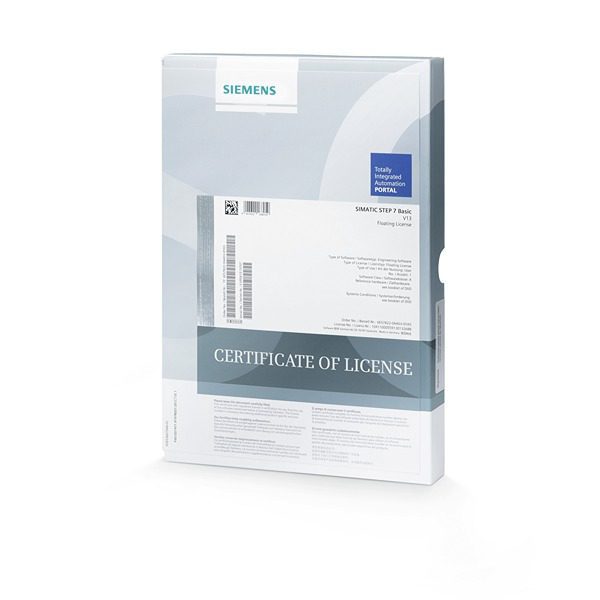
TIA Portal software
Totally integrated automation is a development environment that combines PLC (programming), HMI(visualisation) and startdrive(drive technology).
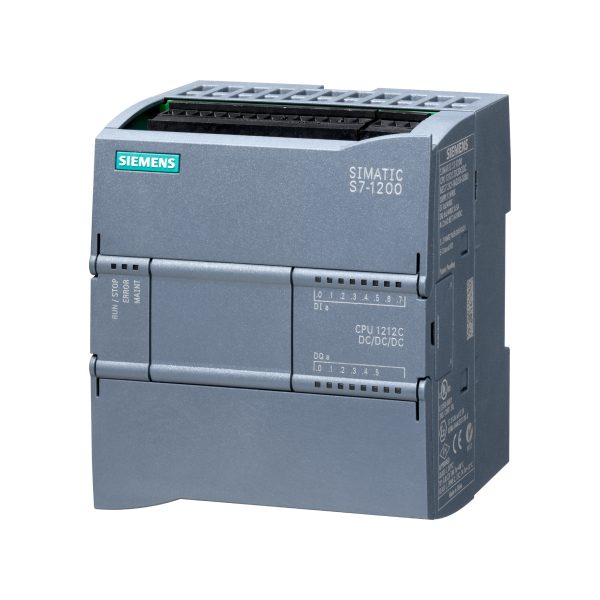
CPU S7-1200
The new controller, which has been developed as a successor to the S7-200, is characterised by slightly weaker parameters than the S7-300 family. Several CPU versions present in the family allow selection according to project requirements.
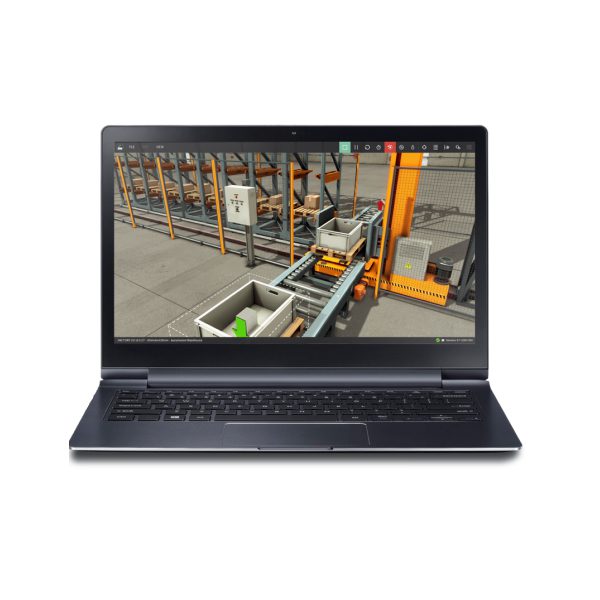
Factory IO
Typical machine scenarios can be run in Factory IO, and the virtual factory connects to the SIM PLC simulator (or the actual PLC. Programming of the controller is possible in the programming environment (depending on the PLC family), and insight into its operation is available during the online connection
What will you be able to do after completing the course?
Investing in completing our paid SIMATIC S7-1200 PLC programming course in FBD language is sure to yield fruitful results. Gaining the ability to program PLCs will open up many career opportunities for you. Choose the specialisation that best suits your interests and you will open up an exciting career path.
In the SIMATIC S7-1200 PLC programming course in FBD language, we don't rely on dry theory. We offer you a unique opportunity to gain practical skills that really matter to employers. Our training is structured in such a way that a person with no previous programming experience can receive ready-made, practical solutions. With this course, you will lay a solid foundation for finding your way in the competitive job market.
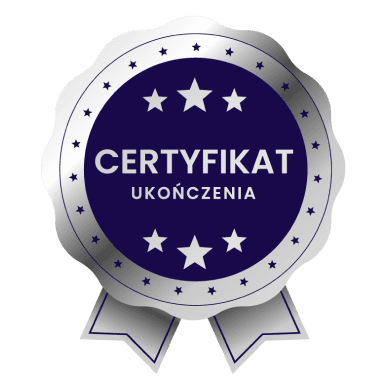
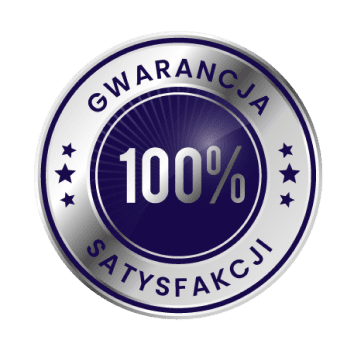
Guarantee
and certificate
If, after 14 days of purchase, you find that it is not for you, I will refund 100% of the course price. Upon completion of the course, you will receive a certificate in two languages - Polish and English.

Frequently asked questions
-
Will I receive a confirmation after my purchase?
Yes, you receive an email. Sometimes emails end up in SPAM or other folders. Please check your mailbox carefully.
-
Is there a difference between the media on which the course can be ordered?
No. The material is the same regardless of the type of storage medium. At the time of purchase, you decide which type of data carrier you choose, i.e. online, DVD or USB.
-
Which PLC programming language should I choose when starting out?
If you are an electrician then LAD. If there has been any exposure to text-based languages (C, C++, C#, Java, etc) then SCL. If there has been no exposure to any programming at all then the basic course is LAD and SCL (the solution to each task is shown in two languages).
-
Is this course for me if I have never used a PLC?
Yes. The basic courses are just set up so that people with no exposure to Siemens PLCs can learn such skills. The student is guided step by step (as can also be seen in the course table of contents).
-
What tools are used for consultation?
Consultations take place via Skype or TeamViever.
-
How do I make an appointment for a consultation?
Please send an email to biuro@plcspace.pl with your questions (problems) and suggestions for a convenient date for your consultation (via Skype or Teamviever).
-
How long are the consultations valid?
This is 60 calendar days from the date of purchase.
-
Can I deliver the course on different computers?
Yes. The course material (videos) can be viewed on any computer.
-
What does the online version of the course look like?
You receive the course by email, where there are private links to the videos.
-
What if a problem arises during the course?
Please email me with a description of the problem at: biuro@plcspace.pl.
-
What is the access time for the course?
No time limits for any medium (i.e. online, DVD or USB version).
-
Do I need to have any experience with programming?
No. The basic course gives step-by-step all the information needed from 'scratch'.
-
Will I need to purchase a licence for the Factory IO software?
No. There is information in the course on how to obtain licences to complete the material.
-
Will I need to purchase a licence for the PLC development environment?
No. There is information in the course on how to obtain licences to complete the material.
-
Is it possible to return the course?
Yes.
-
Will I need a PLC to deliver the course?
No. A real controller is not necessary. The course is designed in such a way that it can also be completed on a virtual controller. It all depends on what the trainee has at their disposal.
-
How do I buy a course?
Just click Add to basket and complete the form and make payment.
-
When does the course start?
-> Online version - immediately after payment
-> Physical version - when you receive the package from the carrier.
Buy as a set and save
Select at least 2 courses from the list and the first free book item (three selections in total) and an automatic discount of 25% will be calculated in your basket.
If you want to find out more about a particular course, click on its name and the page will take you to its offerings.
Companies that have benefited from our courses




































Feedback from students
 Stanislaw
Stanislaw
What sets this course apart is the opportunity to acquire practical, concrete knowledge. Everything is clearly explained. Definitely recommended!
 Marcel
Marcel
After going through the course, I know what the components of the programming environment are and what to do step by step. Now I feel confident and know what I am doing
 Leon
Leon
Course delivered in a very accessible way. Contains a lot of interesting and useful information.
 Michael
Michael
I can honestly recommend the course. It is solid and factual knowledge. I will definitely be buying more.
 Victor
Victor
Thanks to the course, I have decided to go further in this direction. The goal is to look for a more challenging and better job
 Peter
Peter
The course prepared by Mr Tomasz is distinguished by its high level of content and meticulously prepared lessons. They are planned in a clear and sensible manner, making it easier to assimilate knowledge and return to the material if necessary. An additional advantage is the possibility of a free consultation.
 Nikodem
Nikodem
Definitely recommended! The facts themselves, no unnecessary dwelling on issues.
 Ignatius
Ignatius
This is my first course, certainly not my last. I am impressed with the substantive quality of the knowledge.
 Tymon
Tymon
Everything clearly explained, you can really learn a lot. Lots of practical information and examples to help you remember everything. In my opinion, it is worth using this form of learning because you can learn anytime and anywhere. It is practical and convenient.
You may also be interested in:
- Level:
The development environment used in the course
- Software:
Core unit family used in the course
- CPU:
A set of rules that are used to develop programme code
- Language:
Frequency converter (inverter) family used in the course
- Drive
39.00 zł
- Level:
The development environment used in the course
- Software:
Core unit family used in the course
- CPU:
A set of rules that are used to develop programme code
- Language:
Frequency converter (inverter) family used in the course
- Drive
39.00 zł
- Level:
The development environment used in the course
- Software:
Core unit family used in the course
- CPU:
A set of rules that are used to develop programme code
- Language:
Frequency converter (inverter) family used in the course
- Drive
1.824.00 zł
- Level:
The development environment used in the course
- Software:
Core unit family used in the course
- CPU:
A set of rules that are used to develop programme code
- Language:
Frequency converter (inverter) family used in the course
- Drive
39.00 zł
